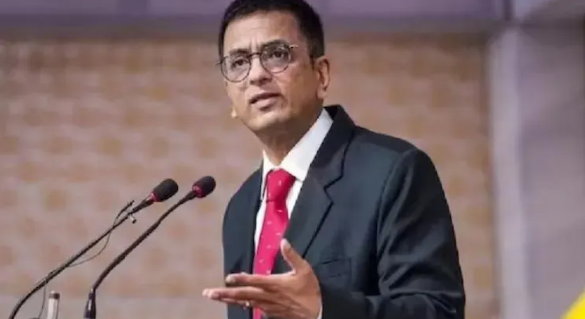Supreme Court Calls for Government Response on Judicial Appointment Delays (GS Paper 2, Governance)

Context
- The Supreme Court of India, under the leadership of Chief Justice D.Y. Chandrachud, has demanded a detailed report from the government regarding the significant backlog of judicial appointments that have been reiterated by the Collegium but remain unapproved.
- This move underscores the court's stance that the Collegium serves a critical role within the constitutional framework, implying that the government should not have the sole authority to accept or reject these recommendations without proper justification.
Background of the Case
- The court's inquiry was initiated during the hearing of a Public Interest Litigation (PIL) seeking to establish a fixed timeline for the government to officially announce judicial appointments that have been recommended by the Collegium.
- Additionally, a contempt plea from the Jharkhand government highlighted the delays in the transfer of Himachal Pradesh High Court Chief Justice M.S. Ramachandra Rao to the Jharkhand High Court, exacerbating concerns over the judicial appointment process.
The Collegium System Explained
Constitutional Framework
The Collegium system is rooted in Articles 124 and 217 of the Indian Constitution, which delineate the appointment processes for Supreme Court and High Court judges:
- Article 124(2): Specifies that judges of the Supreme Court are appointed by the President of India after consulting the Chief Justice of India (CJI) and other judges as deemed necessary. This article provides a broad framework for appointments but leaves the final decision in the hands of the executive.
- Article 217: Similar to Article 124, this article outlines the appointment of High Court judges, requiring the President to consult the CJI and the Governor of the respective state.
Initially, these constitutional provisions granted significant authority to the executive branch in the appointment process. However, various Supreme Court interpretations led to the establishment of the Collegium system, which prioritizes judicial involvement in these decisions.
Evolution of the Collegium System
The Collegium system has evolved through a series of landmark judicial pronouncements:
- First Judges Case (1982): This case defined "consultation" as not necessarily implying "concurrence," thus granting more primacy to the executive in the appointment process. The ruling suggested that while consultation is necessary, it does not bind the President to follow the CJI's advice.
- Second Judges Case (1993): In a pivotal reversal, the Supreme Court established that the CJI’s advice on judicial appointments is binding and must consider the views of two of the senior-most judges of the Supreme Court. This marked a shift towards greater judicial control over appointments.
- Third Judges Case (1998): This case further solidified the CJI's role, mandating that the CJI must consult the four senior-most judges when recommending appointments. The court ruled that if a majority of the Collegium opposes a particular candidate, that candidate should not be appointed. This decision reinforced the principle of collective decision-making within the Collegium.
Role and Responsibilities of the Collegium
The Collegium system plays several crucial roles in maintaining the integrity and independence of the judiciary:
- Appointments: The Collegium for appointing Supreme Court judges comprises the CJI and the four senior-most judges. For High Court judges, the Collegium consists of the CJI and two senior-most judges. Recommendations from the Collegium are sent to the government for approval, but the government can only return these recommendations for reconsideration, not outright reject them if the decision has been reiterated.
- Transfers: The Collegium also oversees the transfer of judges among different High Courts. This mechanism is vital for ensuring judicial independence, as it prevents judges from developing local biases and helps maintain the impartiality of the judiciary.
- Independence from Political Influence: The primary objective of the Collegium system is to ensure that judicial appointments are insulated from political and executive pressures. By vesting appointment authority within the judiciary, the system seeks to uphold the independence and integrity of the courts.
Ongoing Tensions Between Judiciary and Executive
The relationship between the judiciary and the executive has been marked by ongoing tensions, particularly concerning delays in judicial appointments and transfers.
- Government Critique: The Centre has characterized the Collegium system as opaque and non-transparent, raising concerns about its lack of accountability. Critics argue that this system may lead to arbitrary decision-making and lack of diversity in judicial appointments.
- Judicial Defense: On the other hand, many current and former justices of the Supreme Court assert that the Collegium system is the best mechanism for safeguarding judicial independence. They argue that the judiciary must have a predominant role in appointments to avoid potential political manipulation.
- Impact of Delays: Delays in the appointment and transfer of judges have not only resulted in significant backlogs but have also led to an erosion of public confidence in the judicial system. These delays can impact the overall efficiency of the judiciary, affecting the timely delivery of justice.
Conclusion
- The Supreme Court's call for a response from the government highlights the critical nature of judicial appointments in maintaining the balance of power between the judiciary and the executive.
- As the judiciary strives to uphold its independence, the ongoing dialogue surrounding the Collegium system is essential for ensuring a transparent and effective process for judicial appointments.
- Addressing the backlog and fostering a collaborative relationship between the judiciary and the executive will be crucial for the future of India’s legal framework and the delivery of justice.


